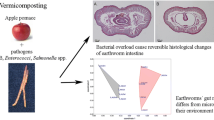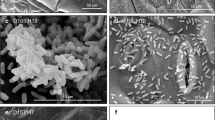Abstract
Vermicomposting is a process by which earthworms together with microorganisms degrade organic wastes into a humus-like material called vermicompost. This process does not include a thermophilic stage, and therefore, the possible presence of pathogens represents a potential health hazard. To elucidate the effect of earthworms in the selective reduction of pathogens, grape marc substrate was artificially inoculated with Escherichia coli, Enterococcus spp., thermotolerant coliform bacteria (TCB), and Salmonella spp., and their reduction during vermicomposting was monitored. Various defense mechanisms eliminating microorganisms in the earthworm gut were assumed to be involved in the process of pathogen reduction. Therefore, we followed the expression of three pattern recognition receptors (coelomic cytolytic factor (CCF), lipopolysaccharide-binding protein (LBP), and Toll-like receptor (v-TLR)), two antimicrobial molecules (fetidin/lysenins and lysozyme), and heat shock protein HSP70. We detected the significant decrease of some defense molecules (fetidin/lysenins and LBP) in all pathogen-inoculated substrates, and the increase of CCF and LBP in the Salmonella spp.-inoculated substrate. At the same time, the reduction of pathogens during vermicomposting was assessed. We observed the accelerated reduction of E. coli, Enterococcus spp., and TCB in pathogen-inoculated substrates with earthworms compared to that without earthworms. Moreover, the differences between the microbiome of grape marc substrate and earthworm intestines were determined by high throughput sequencing. This analysis revealed that the bacterial composition of grape marc substrate differed from the composition of the content of earthworm intestines, suggesting the elimination of specific bacterial species during food passage through the gut.



Similar content being viewed by others
Abbreviations
- CCF:
-
Coelomic cytolytic factor
- CFU:
-
Colony-forming unit
- LBP:
-
Lipopolysaccharide-binding protein
- PRR:
-
Pattern recognition receptor
- TCB:
-
Thermotolerant coliform bacteria
- TLR:
-
Toll-like receptor
References
Affar EB, Dufour M, Poirier GG, Nadeau D (1998) Isolation, purification and partial characterization of chloragocytes from the earthworm species Lumbricus terrestris. Mol Cell Biochem 185:123–133
Aira M, Gomez-Brandon M, Gonzalez-Porto P, Dominguez J (2011) Selective reduction of the pathogenic load of cow manure in an industrial-scale continuous-feeding vermireactor. Bioresour Technol 102:9633–9637
Aira M, Bybee S, Perez-Losada M, Dominguez J (2015) Feeding on microbiomes: effects of detritivory on the taxonomic and phylogenetic bacterial composition of animal manures. FEMS Microbiol Ecol 91(11):1–10
Beschin A, Bilej M, Hanssens F, Raymakers J, Van Dyck E et al (1998) Identification and cloning of a glucan- and lipopolysaccharide-binding protein from Eisenia foetida earthworm involved in the activation of prophenoloxidase cascade. J Biol Chem 273:24948–24954
Bilej M, De Baetselier P, Van Dijck E, Stijlemans B, Colige A et al (2001) Distinct carbohydrate recognition domains of an invertebrate defense molecule recognize Gram-negative and Gram-positive bacteria. J Biol Chem 276:45840–45847
Bodo K, Ernszt D, Nemeth P, Engelmann P (2018) Distinct immune-and defense-related molecular fingerprints in sepatated coelomocyte subsets of Eisenia andrei earthworms. ISJ 15:338–345
Chen Y, Zhang Y, Zhang Q, Xu L, Li R, Luo X, Zhang X, Tong J (2015) Earthworms modify microbial community structure and accelerate maize stover decomposition during vermicomposting. Environ Sci Pollut Res Int 22:17161–17170
Cole JR, Wang Q, Fish JA, Chai BL, McGarrell DM et al (2014) Ribosomal database project: data and tools for high throughput rRNA analysis. Nucleic Acids Res 42:D633–D642
Dvorak J, Mancikova V, Pizl V, Elhottova D, Silerova M et al (2013) Microbial environment affects innate immunity in two closely related earthworm species Eisenia andrei and Eisenia fetida. PLoS One 8:e79257
Dvorak J, Roubalova R, Prochazkova P, Rossmann P, Skanta F et al (2016) Sensing microorganisms in the gut triggers the immune response in Eisenia andrei earthworms. Dev Comp Immunol 57:67–74
Edwards CA (2010) Human pathogen reduction during vermicomposting. In: Edwards CA, Arancon NQ, Sherman RL (eds) Vermiculture technology: earthworms, organic wastes and environmental management. CRC Press, Boca Raton
Hanc A, Pliva P (2013) Vermicomposting technology as a tool for nutrient recovery from kitchen bio-waste. J Mater Cycles Waste Manag 15:431–439
Homa J, Zorska A, Wesolowski D, Chadzinska M (2013) Dermal exposure to immunostimulants induces changes in activity and proliferation of coelomocytes of Eisenia andrei. J Comp Physiol B 183:313–322
Homa J, Stalmach M, Wilczek G, Kolaczkowska E (2016) Effective activation of antioxidant system by immune-relevant factors reversely correlates with apoptosis of Eisenia andrei coelomocytes. J Comp Physiol B 186:417–430
Joskova R, Silerova M, Prochazkova P, Bilej M (2009) Identification and cloning of an invertebrate-type lysozyme from Eisenia andrei. Dev Comp Immunol 33:932–938
Kiernan JA (2008) Histological and histochemical methods: theory and practice, fourth edn. Scion Publishing Ltd, UK
Lung AJ, Lin CM, Kim JM, Marshall MR, Nordstedt R et al (2001) Destruction of Escherichia coli O157:H7 and Salmonella enteritidis in cow manure composting. J Food Prot 64:1309–1314
Monroy FMA, Domínguez J (2008) Changes in density of nematodes, protozoa and total coliforms after transit through the gut of four epigeic earthworms (Oligochaeta). Appl Soil Ecol 39:127–132
Monroy F, Aira M, Dominguez J (2009) Reduction of total coliform numbers during vermicomposting is caused by short-term direct effects of earthworms on microorganisms and depends on the dose of application of pig slurry. Sci Total Environ 407:5411–5416
Pachepsky YA, Sadeghi AM, Bradford SA, Shelton DR, Guber AK, Dao T (2006) Transport and fate of manure-borne pathogens: modeling perspective. Agric Water Manag 86:81–92
Pass DA, Morgan AJ, Read DS, Field D, Weightman AJ, Kille P (2015) The effect of anthropogenic arsenic contamination on the earthworm microbiome. Environ Microbiol 17:1884–1896
Prochazkova P, Silerova M, Felsberg J, Joskova R, Beschin A et al (2006) Relationship between hemolytic molecules in Eisenia fetida earthworms. Dev Comp Immunol 30:381–392
Prochazkova P, Hanc A, Dvorak J, Roubalova R, Dreslova M et al (2018) Contribution of Eisenia andrei earthworms in pathogen reduction during vermicomposting. Environ Sci Pollut Res Int 25:26267–26278
Roubalova R, Dvorak J, Prochazkova P, Elhottova D, Rossmann P et al (2014) The effect of dibenzo-p-dioxin- and dibenzofuran-contaminated soil on the earthworm Eisenia andrei. Environ Pollut 193:22–28
Roubalova R, Dvorak J, Prochazkova P, Skanta F, Navarro Pacheco NI et al (2018) The role of CuZn- and Mn-superoxide dismutases in earthworm Eisenia andrei kept in two distinct field-contaminated soils. Ecotoxicol Environ Saf 159:363–371
Segata N, Izard J, Waldron L, Gevers D, Miropolsky L, Garrett WS, Huttenhower C (2011) Metagenomic biomarker discovery and explanation. Genome Biol 12:R60
Sinha RK, Herat S, Bharambe G, Brahambhatt A (2010) Vermistabilization of sewage sludge (biosolids) by earthworms: converting a potential biohazard destined for landfill disposal into a pathogen-free, nutritive and safe biofertilizer for farms. Waste Manag Res 28:872–881
Skanta F, Roubalova R, Dvorak J, Prochazkova P, Bilej M (2013) Molecular cloning and expression of TLR in the Eisenia andrei earthworm. Dev Comp Immunol 41:694–702
Skanta F, Prochazkova P, Roubalova R, Dvorak J, Bilej M (2016) LBP/BPI homologue in Eisenia andrei earthworms. Dev Comp Immunol 54:1–6
Soobhany N (2018) Preliminary evaluation of pathogenic bacteria loading on organic Municipal Solid Waste compost and vermicompost. J Environ Manag 206:763–767
Swati A, Hait S (2018) A comprehensive review of the fate of pathogens during vermicomposting of organic wastes. J Environ Qual 47:16–29
Turner C (2002) The thermal inactivation of E-coli in straw and pig manure. Bioresour Technol 84:57–61
Vetrovsky T, Baldrian P (2013) Analysis of soil fungal communities by amplicon pyrosequencing: current approaches to data analysis and the introduction of the pipeline SEED. Biol Fertil Soils 49:1027–1037
Yu Y, Lee C, Kim J, Hwang S (2005) Group-specific primer and probe sets to detect methanogenic communities using quantitative real-time polymerase chain reaction. Biotechnol Bioeng 89:670–679
Acknowledgements
The authors thank L. Matějů for technical help with selective bacterial cultivation.
Funding sources
This research was supported by the Institutional Research Concept RVO 61388971 and by the Ministry of Agriculture of the Czech Republic under the NAZV project No. QJ1530034 and by CULS Prague under the CIGA project No. 20172018.
Author information
Authors and Affiliations
Corresponding author
Additional information
Responsible editor: Philippe Garrigues
Publisher’s note
Springer Nature remains neutral with regard to jurisdictional claims in published maps and institutional affiliations.
Highlights
Earthworms accelerated the reduction of pathogens in most of the tested substrates.
Some defense molecules were upregulated in earthworms kept in the pathogen-inoculated substrate.
Under great bacterial load, the earthworm gut underwent reversible histological changes.
The microbiome of the earthworm gut differed from that of grape marc substrate.
Electronic supplementary material
ESM1
(DOCX 36 kb)
Rights and permissions
About this article
Cite this article
Roubalová, R., Procházková, P., Hanč, A. et al. Mutual interactions of E. andrei earthworm and pathogens during the process of vermicomposting. Environ Sci Pollut Res 27, 33429–33437 (2020). https://doi.org/10.1007/s11356-019-04329-5
Received:
Accepted:
Published:
Issue Date:
DOI: https://doi.org/10.1007/s11356-019-04329-5




